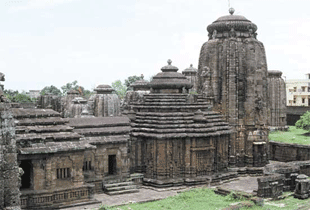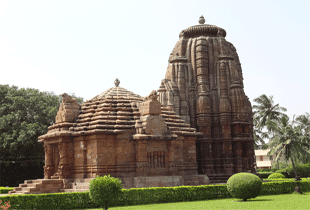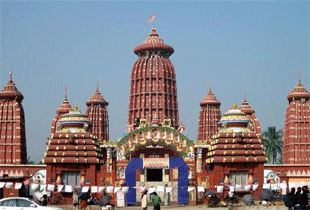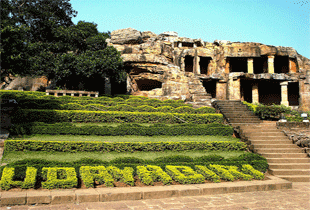Bhubaneswar, India
Situated in the eastern side of the state of Odisha, Bhubaneswar is the capital city of the state. The city comprises a history of more than 3,000 years beginning from the Mahamegha-bahana Chedi dynasty having its capital at Sisupalgarh. The name of the city is derived from Tribhubaneswar, which exactly means the Lord (Ishwar) of the three worlds. The city has been known with various names till now. At present, Bhubaneswar is the largest city of the state and is the hub of economic and religious developments in Eastern India. The city is home to several majestic Hindu temples and shrines, which create key tourist attractions of Bhubaneswar.
With a lot of incredible Hindu temples spanning the entire spectrum of Kalinga architecture, Bhubaneswar is frequently called as the 'Temple City of India'. It serves as the perfect fusion of traditional customs, age-old beautiful culture and contemporary aspirations. This is one of the biggest reasons that tourism in Bhubaneswar is getting energy with every passing day. The city is witnessing growing population of travelers from various parts of India and the world to discover it exceptional splendor. History of Bhubaneswar can be analyzed in ancient and modern times. The ancient era of city is comprised of around thousands years while modern city materialized in year 1948.
In this year, Bhubaneswar substituted Cuttack as the capital post independence of India from British rule. The present-day’s Bhubaneswar was planned by a German architect named Otto Königsberger. Apart from cities of Jamshedpur and Chandigarh, Bhubaneswar too was one of the first planned cities of contemporary India. Bhubaneswar and Cuttack are often called as the 'twin cities of Odisha'. By emerging as a hub of education and information technology (IT), Bhubaneswar has become one of the fastest growing cities of India. People travel to Bhubaneswar with a purpose to explore abundant of admired Hindu temples. Other places to explore in this city are museums
Visit in Bhubaneswar
Whenever tourists plan sightseeing tours in Bhubaneswar, the temples of the city hold the topmost position in the list of the tourist attractions in Bhubaneswar. The city bestows a splendid past of the temples dating back to the time of the Kalinga Empire, which is more than 25 centuries old. Devotees come to Bhubaneswar from various parts of India and world to explore these marvelous temples. Along with temples, numerous places to visit in Bhubaneswar are available. In the following lines, get information about top places that you can visit on tour of Bhubaneswar.
One among the most visited temples of India, Lingaraj Temple is a must visit tourist attraction in Bhubaneswar. The main deity of temple is Lord Shiva, who is also popular as 'Lingaraj'. The temple is decorated with striking sculptures, which have been incredibly carved on the spire. The temple houses a huge granite idol of Lord Shiva, which is 8 feet in diameter. The idol is enshrined over a platform that is around 8 inches above ground. The main things offered to the deity are water, milk and bhang.
Situated north of the Lingaraja Temple, Bindusagar Lake is another popular tourist attraction in Bhubaneswar. In fact, the lake is becoming more popular now a day amongst the tourists as well as locals as a picnic spot. The lake is 1300 feet long and 700 feet wide. The lake is bordered with beautiful stones that enhance its beauty. The entire environment of the lake is so calm that it instantly refreshes the visitors. The lake is situated amidst numerous temples of Bhubaneswar.
Mukteshwar temple is one of the well-known temples of Bhubaneswar, which has been built in the typical style of the Kalinga School of Temple Architecture. With marvelous Toran of the temple and decorative domed entrance, the temple reminds you of the influence of Buddhism in Odisha. The temple was founded in 950 AD and is dedicated to Lord Shiva. The major highlights of the temple consist of the delicate carvings depicting ascetics in various meditative pose.
Rajarani Temple is also one of the most popular temples in Bhubaneswar, which is constructed using magnificent red and gold sandstone. These red & gold sandstones are locally known as Rajarani in the city that gave name to this temple. It is one of the best places of tourist interest in Bhubaneswar that comprised of elaborately carved figurines. The temple is dedicated to Lord Brahma.
The foundation of Orissa State Museum is tracked back to the year 1932. It was established by two historians; Professor N. C. Banerjee and Professor Ghanshyam Dash of Ravenshaw College in order to preserve their archaeological treasures and findings from various places. You get the chance to explore an exotic world of past on the moment of entering into this museum. In the museum, there is an Epigraphy Gallery, a wonderful compilation of patta paintings, brassware, stone sculptures and popular silver filigree work of the state.
Located about 7 to 8 KM away from the city of Bhubaneswar, Udaygiri Caves are about 135 feet high while Khandagiri caves are 118 feet high. These caves are one of greatest places of interest in the city offering influence of Buddhism and Jainism in the state. The origin of the Udaygiri and Khandagiri caves dates back to the 2nd century BC. The astonishing carvings are the greatest attraction of these caves.
Dhauli Hill is one of the most popular Buddhist pilgrim destinations in India, which is 8 km away from Bhubaneswar. The hill is the place where Emperor Ashoka’s hearted melted on seeing the carnage of Kalinga War and he adopted Buddhism. There is a Shanti Stupa on this hill, which is built by the Indians, in alliance with Japanese.
Located 20 km away from Bhubaneswar, Nandankanan National Park is another popular place to visit on your Bhubaneswar trip. Despite being a zoological park, it also serves the criteria of a botanical garden. One can see here the rare collection of plants along with various wildlife animals, including White Tiger, Nilgiri Langur, Indian Pangolin, Mouse Deer and many others.
ISKCON stands for ‘International Society for Krishna Consciousness’. There is a beautiful ISKCON temple in the city that houses an iconic white architecture with idols of prime deities like Lord Krishna, Balaram, Gaura Nithai, Subhadra and Lord Jagannath. The temple is primarily known for spreading spiritual knowledge in the world.
Situated in the heart of Bhubaneswar, Ram Mandir is comprised of an ornately carved structure and features striking images of Lord Ram, Lord Lakshman and Goddess Sita. Owing to its high rising spire, the temple is visible from different parts of the city. The temple also features ochre-painted marble statues of Lord Hanuman, Lord Shiva and other deities.
The museum displays an array of primitive murals, traditional costumes, jewelries and household appliances. In the museum, one can also see hunting equipments like bows and arrows, axes and traps for birds and fish. Located at an area of 12-acres, the museum also houses about 2,247 artifacts.
Spread over an area of 10.6 acres, Indira Gandhi Park is the place where Smt. Indira Gandhi gave her last public speech and then was shot dead by her bodyguards on returning Delhi. The park is adorned with beautiful flowers and fountains and is a preferred place for relaxation and walking.
Bhubaneswar, India

March to Mid-June, Warm and Humid
Temperature:28°C – 45°C

July to October, receives heavy rainfall
Annual rainfall -1450 mm

Last November to February, Cool and Charming
Temperature:7°C – 25°C
Sights of Bhubaneswar



